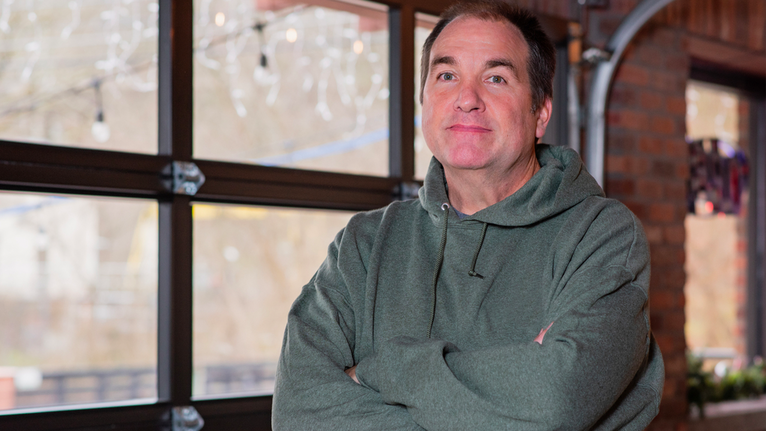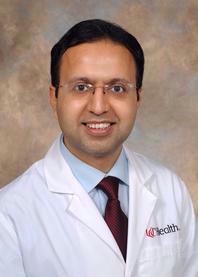Kelley Whigham began his workday at his West Chester, OH office like any other day.
After completing his morning work routine and interviewing a prospective job candidate, he told colleagues he was not feeling well and walked back to his desk.
“I don’t remember any of that day,” Kelley said. “One of my coworkers thought he heard me snoring, so he came to my cubicle and found me unresponsive at my desk.”
A Sudden Cardiac Arrest
Kelley had gone into sudden cardiac arrest. His coworkers immediately started CPR and called the ambulance. When the squad arrived, they continued to perform three additional rounds of CPR and used an automated external defibrillator, or AED, to deliver three electrical shocks that re-established an effective heart rhythm.
Every year in the U.S., approximately 395,000 cases of cardiac arrest occur outside of a hospital setting, in which less than 6%survive, according to the National Academies of Sciences, Engineering and Medicine. Approximately 200,000 cardiac arrests occur each year in hospitals, and 24% of those patients survive.
After receiving treatment at the scene, Kelley was transported to UC Health’s West Chester Hospital, where a multidisciplinary team of doctors and clinicians worked diligently to ensure he received optimal care.
“Those patients who are suffering from severe cardiac arrest complications need an immediate and higher level of care,” Christopher Richards, MD, UC Health emergency medicine physician at West Chester Hospital and associate professor at the University of Cincinnati College of Medicine said.
Typically, patients like Kelley are transported to UC Health’s University of Cincinnati Medical Center in Clifton. When Kelley arrived at West Chester Hospital, his condition was not stable—so unstable that he was not able to be transported to UC Medical Center, the region’s only Level I trauma center.
Naseer Khan, MD, UC Health interventional cardiologist and assistant professor at the University of Cincinnati College of Medicine, was on the scene when Kelley arrived.
“For Kelley, each passing minute was taking his life away,” he said. “Our team, which included emergency medicine physicians and nurses, moved quickly to take Kelley to the Cardiac Catheterization Lab. He underwent an emergent procedure to look at his heart arteries.”
The "Widow Maker" Artery
“We found 100% blockage in the left anterior descending artery,” Dr. Khan continued. “This is often referred to as the ‘widow maker artery', as anyone who has this kind of blockage usually dies almost immediately unless they receive appropriate and timely care. And even if they somehow make it to the hospital, they usually do not do very well. Because this artery supplies a significant amount of blood flow to the heart muscle, harmful blockage stifles oxygen flow and can trigger an abnormal heart rhythm called ventricular fibrillation.”
Treatment: Therapeutic Hypothermia after a Cardiac Arrest
Once Kelley arrived at the West Chester Hospital Emergency Department, he was rushed to the Cardiac Catheterization Laboratory where Dr. Khan placed a stent in the heart artery and restored blood flow to the heart. He was placed on a ventilator while his blood pressure stabilized, and the team decided to place him into hypothermia protocol. Therapeutic hypothermia is a treatment that is sometimes used for people who have a cardiac arrest.
“By lowering the body temperature, you can lower the chance of permeant damage to the vital organs—especially the brain,” Dr. Khan said. “After 48 hours in the Intensive Care Unit, a CT scan was performed to determine Kelley’s health status as well as brain function. He walked out of the hospital a few days later.”
A Second Chance at Life
Dr. Khan says that without CPR and immediate care administered at the scene, it is very unlikely that Kelley would be alive today. He encourages people in the community to become educated on how to administer CPR and to consider AED training for the workplace as well.
“It’s the best thing you can do to save a life,” Dr. Khan stated.
Because Kelley had not experienced many health issues before the heart attack, the experience still leaves him feeling shocked.
“I had no indication beforehand that it was going to happen,” he said. “It was maddening. I had no pain, no shortness of breath, no fatigue—it just suddenly took me out.”
Today, Kelley believes that he has been given a second chance at life. He walks up to 12 miles every day and makes regular exercise a priority throughout the week.
“The biggest change is that I am doing a lot of activities outside, especially with my grandkids,” he said. “Now instead of wasting my time, I am doing all the things I wanted to do before the attack. I’m reading all the books I have collected over the years and I am enjoying the things that I said I was going to do before but never did.”
Discover More
UC Health makes it a priority to provide resources and training to improve prehospital care, and to help the public prepare to take action in the event of a medical emergency, like a heart attack or sudden cardiac arrest. TAKE10 Cincinnati, powered by UC Health, is a free, 10-minute training designed to educate the community about compression-only CPR, an easy-to-learn technique that can save lives. TAKE10 is compression-only, so there is no mouth-to-mouth.
This program aims to help you build your confidence and focuses on 3 key STEPS:
- First, check for responsiveness and normal breathing.
- Second, call 911.
- Third, compress hard and fast in the center of the chest until help arrives.
The more people in our community who receive TAKE10 training, the better chance we all have of surviving a sudden cardiac arrest. If you’re interested in setting up a TAKE10 training at your business or community group, please email: take10@uchealth.com.

